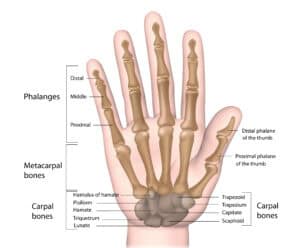With the flick of the wrist, a cricketer plays masterstrokes that make the team win matches. The same wrist is as work when you sweep and dust to keep your house clean. Our wrists do much more than just exist as a part of our bodies from where we can feel our pulse. Every time you want to know the time you look at your wrist, every time you hold something it involves your wrist. From typing to writing, cooking and even playing sports, our wrists make sure we are able to seamlessly move our hands to our needs. So when the wrists start to hurt, that’s when we realise exactly how much it contributes to a good quality of life for us.
So what can cause wrist pain? And what are the ways in which you can treat them?
Table of Contents
The wrist is a joint, connecting your hand and forearm. The wrist joint is made up of many small bones, which enable you to bend, straighten and rotate your hand. If you experience pain, numbness or tingling sensation in this region, then you are suffering from wrist pain. However, there is no need to be concerned about this pain as it is completely treatable. So now let us understand what are the reasons behind this pain in the next section.
As per the research carried out on risk factors associated with wrist pain by experts at the BMC Musculoskeletal Disorders, it was observed that women (14.7%) have a higher risk of getting wrist pain than men (5.6%). The study also indicated that those employed in manual labour and those who work out with weights are at a higher risk of getting wrist pain.
Source: https://d-nb.info/1206413336/34
Primarily any trauma impact on any part of the body will make it painful. So, if you have experienced a fall, and you have landed on your wrist, then it is bound to pain, due to the stress and trauma exposed to it. An X-ray will reveal whether this impact resulted in a sprain, fracture, or partial ligament disruption.

Otherwise, sometimes aches and pains may tend to appear out of the blue, with symptoms that may come and go. When the symptoms start getting worse or do not seem to subside for days then this will be termed chronic pain in the wrist. Get a healthcare provider to carefully examine the pain and obtain appropriate imaging studies to isolate the cause of the pain.
Some of the most identified causes of wrist pain are:
Depending on the cause of the pain the treatment approach will differ.
At home, you may do the following to help manage the pain:
If the orthopaedic identifies that the pain is chronic, then they might recommend
These days orthopaedic surgeons prefer using arthroscopic (minimally invasive) techniques to ensure a speedy recovery and complete treatment.
It is always said by medical practitioners that prevention is always better than cure. In the case of wrist pain, repetitive movements can tend to make it hurt more. For example, we all spend a lot of time typing. So you can avoid wrist pain from it by:
In conclusion, the underlying cause of pain once identified can help locate the cause and enable your healthcare partner to apply the appropriate treatment for it. When in doubt regarding pain that refuses to go away on its own, always reach out to a hand and wrist expert who will help resolve your problem. At the CK Birla Hospital, our award-winning team of experts and orthopaedic surgeons will provide the best solution with the fastest chance of recovery.